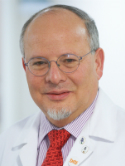| Abstract: |
Purpose We report the long-term results of integrated accelerated involved field radiation therapy (IFRT) followed by total lymphoid irradiation (TLI) as part of the high-dose salvage regimen followed by autologous bone marrow transplantation or autologous stem cell transplantation in patients with relapsed or refractory Hodgkin lymphoma (HL). Methods and Materials From November 1985 to July 2008, 186 previously unirradiated patients with relapsed or refractory HL underwent salvage therapy on 4 consecutive institutional review board–approved protocols. All patients had biopsy-proven primary refractory or relapsed HL. After standard-dose salvage chemotherapy (SC), accelerated IFRT (18-20 Gy) was given to relapsed or refractory sites, followed by TLI (15-18 Gy) and high-dose chemotherapy. Overall survival (OS) and event-free survival (EFS) were analyzed by Cox analysis and disease-specific survival (DSS) by competing-risk regression. Results With a median follow-up period of 57 months among survivors, 5- and 10-year OS rates were 68% and 56%, respectively; 5- and 10-year EFS rates were 62% and 56%, respectively; and 5- and 10-year cumulative incidences of HL-related deaths were 21% and 29%, respectively. On multivariate analysis, complete response to SC was independently associated with improved OS and EFS. Primary refractory disease and extranodal disease were independently associated with poor DSS. Eight patients had grade 3 or higher cardiac toxicity, with 3 deaths. Second malignancies developed in 10 patients, 5 of whom died. Conclusions Accelerated IFRT followed by TLI and high-dose chemotherapy is an effective, feasible, and safe salvage strategy for patients with relapsed or refractory HL with excellent long-term OS, EFS, and DSS. Complete response to SC is the most important prognostic factor. © 2017 Elsevier Inc. |












